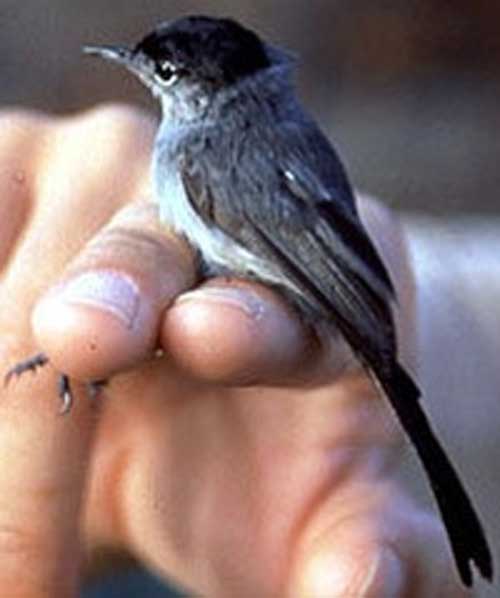
Polioptila californica , Photo: United States Geological Survey
Superregnum: Eukaryota
Cladus: Unikonta
Cladus: Opisthokonta
Cladus: Holozoa
Regnum: Animalia
Subregnum: Eumetazoa
Cladus: Bilateria
Cladus: Nephrozoa
Superphylum: Deuterostomia
Phylum: Chordata
Subphylum: Vertebrata
Infraphylum: Gnathostomata
Megaclassis: Osteichthyes
Cladus: Sarcopterygii
Cladus: Rhipidistia
Cladus: Tetrapodomorpha
Cladus: Eotetrapodiformes
Cladus: Elpistostegalia
Superclassis: Tetrapoda
Cladus: Reptiliomorpha
Cladus: Amniota
Classis: Reptilia
Cladus: Eureptilia
Cladus: Romeriida
Subclassis: Diapsida
Cladus: Sauria
Infraclassis: Archosauromorpha
Cladus: Crurotarsi
Divisio: Archosauria
Cladus: Avemetatarsalia
Cladus: Ornithodira
Subtaxon: Dinosauromorpha
Cladus: Dinosauriformes
Cladus: Dracohors
Cladus: Dinosauria
Ordo: Saurischia
Cladus: Eusaurischia
Subordo: Theropoda
Cladus: Neotheropoda
Cladus: Averostra
Cladus: Tetanurae
Cladus: Avetheropoda
Cladus: Coelurosauria
Cladus: Tyrannoraptora
Cladus: Maniraptoromorpha
Cladus: Maniraptoriformes
Cladus: Maniraptora
Cladus: Pennaraptora
Cladus: Paraves
Cladus: Eumaniraptora
Cladus: Avialae
Infraclassis: Aves
Cladus: Euavialae
Cladus: Avebrevicauda
Cladus: Pygostylia
Cladus: Ornithothoraces
Cladus: Ornithuromorpha
Cladus: Carinatae
Parvclassis: Neornithes
Cohors: Neognathae
Cladus: Neoaves
Cladus: Telluraves
Cladus: Australaves
Ordo: Passeriformes
Subordo: Passeri
Infraordo: Passerida
Superfamilia: Certhioidea
Familia: Polioptilidae
Genus: Polioptila
Species: Polioptila californica
Subspecies: P. c. atwoodi – P. c. californica – P. c. margaritae
Synonym: P. c. pontilis
Name
Polioptila californica Brewster, 1881
Type locality: Riverside, San Bernardino Co. [= Riverside Co.], California.
References
Brewster, W. 1881. On the affinities of certain Polioptilae with a description of a new species. Bulletin of the Nuttall Ornithological Club 6 no.2: 101–107 BHL Reference page. Original description p. 103 BHL
Vernacular names
čeština: leskot kalifornský
dansk: Bajasnerresmutte
Deutsch: Kalifornienmückenfänger
English: California Gnatcatcher
español: Perlita Californiana
suomi: kaliforniansääskikerttu
français: Gobemoucheron de Californie
magyar: kaliforniai szúnyogkapó
italiano: Pigliamoschini della California
日本語: オグロブユムシクイ, ogurobuyumushikui
Nederlands: Californische Muggenvanger
norsk: Kaliforniamyggsmett
polski: siwuszka kalifornijska
português: Balança-rabo-da-california
русский: Калифорнийская комароловка
slovenčina: sivuška kalifornská
svenska: Kalifornisk myggsnappare
中文: 加州蚋莺
The California gnatcatcher (Polioptila californica) is a small 10.8 cm (4.3 in) long insectivorous bird which frequents dense coastal sage scrub growth. This species was recently split from the similar black-tailed gnatcatcher of the Sonoran and Chihuahuan deserts. This bird is often solitary, but joins with other birds in winter flocks.
Contents
1 Description
2 Diet
3 Habitat
4 Ecology and reproduction
5 Footnotes
6 References
7 External links
Description
The male California gnatcatcher is dusky gray overall, distinguished only by its black crown and thin black beak. It has a long, thin black tail with narrow white tips and edges on the underside of the tail feathers. However, the male loses its plumage colors by winter and obtains a plumage color similar to the females. The female is similar to the male, but with a blue-gray instead of a black crown.
In its range from coastal Southern California south through Baja California and Baja California Sur, this inconspicuous non-migratory resident is most often seen flitting hastily into undergrowth, or heard giving its call, which sounds like a kitten's meow, a rising and falling zeeeeer, zeeeeer.
Diet
The California gnatcatcher's diet consists of small insects and spiders.
Habitat
In the northern part of its range (Southern California) this species was listed as Threatened by the United States Fish and Wildlife Service in 1993 due to increasing development in its habitat, coastal sage scrub (current loss of coastal sage scrub in U.S is estimated at 70 to 90 percent).[2] Critical habitat under the Endangered Species Act has been designated for the California gnatcatcher. This species is especially vulnerable as a metapopulation due to its small populations in a limited habitat often live in the prime land to be developed for housing and commerce that can be easily isolated and reduced in size.
Though some of its habitat has been saved in national forests and state parks, its population has been severely fragmented. There are, however, ongoing efforts to preserve more open land in southern California to help ensure that this species will not disappear from its former range. California gnatcatchers are a focal species in many regional habitat conservation planning efforts.
Ecology and reproduction
Monogamous pairs care for their brood of 3–5 eggs in cone-shaped nests. Brown-headed cowbirds are parasites that lay eggs in their nests.[3]
Footnotes
BirdLife International (2018). "Polioptila californica". IUCN Red List of Threatened Species. 2018: e.T22711585A132099401. doi:10.2305/IUCN.UK.2018-2.RLTS.T22711585A132099401.en. Retrieved 12 November 2021.
Mock, P. (2004). "California Gnatcatcher (Polioptila californica)". The Coastal Scrub and Chaparral Bird Conservation Plan: a strategy for protecting and managing coastal scrub and chaparral habitats and associated birds in California. California Partners in Flight.
"California Gnatcatcher (Polioptila californica)". Archived from the original on 26 December 2008.
References
Atwood, J.L.; Bontrager, D.R. (2001). Poole, A.; Gill, F. (eds.). California Gnatcatcher (Polioptila californica). The Birds of North America. Philadelphia, PA: The Birds of North America, Inc.
Mock, P.J. (2004). Unitt, Philip (ed.). California Gnatcatcher. San Diego County Bird Atlas. Vista, CA: San Diego Natural History Museum No. 39. Ibis Publishing Co. pp. 430–433. ISBN 978-0934797214.
Retrieved from "http://en.wikipedia.org/"
All text is available under the terms of the GNU Free Documentation License

